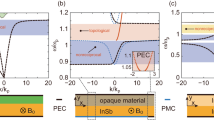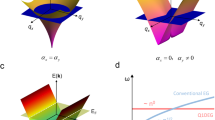Abstract
A metal film perforated by a regular array of subwavelength holes shows unexpectedly large transmission at particular wavelengths, a phenomenon known as the extraordinary optical transmission (EOT) of metal hole arrays1. EOT was first attributed to surface plasmon polaritons, stimulating a renewed interest in plasmonics2,3,4 and metallic surfaces with subwavelength features5,6,7. Experiments soon revealed that the field diffracted at a hole or slit is not a surface plasmon polariton mode alone8. Further theoretical analysis9 predicted that the extra contribution, from quasi-cylindrical waves10,11,12,13, also affects EOT. Here we report the experimental demonstration of the relative importance of surface plasmon polaritons and quasi-cylindrical waves in EOT by considering hole arrays of different hole densities. From the measured transmission spectra, we determine microscopic scattering parameters which allow us to show that quasi-cylindrical waves affect EOT only for high densities, when the hole spacing is roughly one wavelength. Apart from providing a deeper understanding of EOT, the determination of microscopic scattering parameters from the measurement of macroscopic optical properties paves the way to novel design strategies.
This is a preview of subscription content, access via your institution
Access options
Subscribe to this journal
Receive 51 print issues and online access
$199.00 per year
only $3.90 per issue
Buy this article
- Purchase on Springer Link
- Instant access to full article PDF
Prices may be subject to local taxes which are calculated during checkout


Similar content being viewed by others
References
Ebbesen, T. W., Lezec, H. J., Ghaemi, H. F., Thio, T. & Wolff, P. A. Extraordinary optical transmission through sub-wavelength hole arrays. Nature 391, 667–669 (1998)
Yanik, A. A. et al. An optofluidic nanoplasmonic biosensor for direct detection of live viruses from biological media. Nano Lett. 10, 4962–4969 (2010)
Oulton, R. F. et al. Plasmon lasers at deep subwavelength scale. Nature 461, 629–632 (2009)
Atwater, H. A. & Polman, A. Plasmonics for improved photovoltaic devices. Nature Mater. 9, 205–213 (2010)
Barnes, W. L., Dereux, A. & Ebbesen, T. W. Surface plasmon subwavelength optics. Nature 424, 824–830 (2003)
García de Abajo, F. J. Light scattering by particle and hole arrays. Rev. Mod. Phys. 79, 1267–1290 (2007)
García-Vidal, F. J., Martín-Moreno, L., Ebbesen, T. W. & Kuipers, L. Light passing through subwavelength apertures. Rev. Mod. Phys. 82, 729–787 (2010)
Gay, G. et al. The optical response of nanostructured surfaces and the composite diffracted evanescent wave model. Nature Phys. 2, 262–267 (2006)
Liu, H. T. & Lalanne, P. Microscopic theory of the extraordinary optical transmission. Nature 452, 728–731 (2008)
Lalanne, P. & Hugonin, J. P. Interaction between optical nano-objects at metallo-dielectric interfaces. Nature Phys. 2, 551–556 (2006)
Dai, W. & Soukoulis, C. M. Theoretical analysis of the surface wave along a metal-dielectric interface. Phys. Rev. B 80, 155407 (2009)
Lalanne, P., Hugonin, J. P., Liu, H. T. & Wang, B. A microscopic view of the electromagnetic properties of sub-λ metallic surfaces. Surf. Sci. Rep. 64, 453–469 (2009)
Nikitin, A. Y., García-Vidal, F. J. & Martín-Moreno, L. Surface electromagnetic field radiated by a subwavelength hole in a metal film. Phys. Rev. Lett. 105, 073902 (2010)
Nikitin, A., Yu, Rodrigo, S. G., García-Vidal, F. J. & Martín-Moreno, L. In the diffraction shadow: Norton waves versus surface plasmon polaritons in the optical region. N. J. Phys. 11, 123020 (2009)
Gan, C. H., Lalouat, L., Lalanne, P. & Aigouy, L. Optical quasicylindrical waves at dielectric interfaces. Phys. Rev. B 83, 085422 (2011)
Barnes, W. L., Murray, W. A., Dintinger, J., Devaux, E. & Ebbesen, T. W. Surface plasmon polaritons and their role in the enhanced transmission of light through periodic arrays of subwavelength holes in a metal film. Phys. Rev. Lett. 92, 107401 (2004)
Stolwijk, D. et al. Enhanced coupling of plasmons in hole arrays with periodic dielectric antennas. Opt. Lett. 33, 363–365 (2008)
Yin, L. et al. Subwavelength focusing and guiding of surface plasmons. Nano Lett. 5, 1399–1402 (2005)
Lalanne, P., Sauvan, C., Hugonin, J. P., Rodier, J. C. & Chavel, P. Perturbative approach for surface plasmon effects on flat interfaces periodically corrugated by subwavelength apertures. Phys. Rev. B 68, 125404 (2003)
Maystre, D., Fehrembach, A.-L. & Popov, E. Plasmonic antiresonance through subwavelength hole arrays. J. Opt. Soc. Am. A 28, 342–355 (2011)
Born, M. & Wolf, E. Principles of Optics (Pergamon, 1986)
Palik, E. D. Handbook of Optical Constants of Solids 286–295 (Academic, 1985)
Bethe, H. A. Theory of diffraction by small holes. Phys. Rev. 66, 163–182 (1944)
van der Molen, K. L. et al. Role of shape and localized resonances in extraordinary transmission through periodic arrays of subwavelength holes: experiment and theory. Phys. Rev. B 72, 045421 (2005)
van Beijnum, F., Rétif, C., Smiet, C. B. & van Exter, M. P. Transmission processes in random patterns of subwavelength holes. Opt. Lett. 36, 3666–3668 (2011)
Acknowledgements
We acknowledge E. R. Eliel for discussions. H.L. acknowledges a Poste Rouge fellowship from CNRS and the 973 Program (2013CB328701). This work is part of the research program of the Foundation for Fundamental Research on Matter (FOM), which is part of the Netherlands Organisation for Scientific Research (NWO).
Author information
Authors and Affiliations
Contributions
F.v.B. was the primary researcher on the project; he designed the experiment and wrote the paper. With C.B.S., F.v.B. conducted the experiments and analysed the data. C.R. made the samples. H.L., P.L. and M.P.v.E. made essential contributions to interpreting the results and writing the manuscript.
Corresponding author
Ethics declarations
Competing interests
The authors declare no competing financial interests.
Supplementary information
Supplementary Information
This file contains a more elaborate discussion of the theoretical framework used in the main article. It contains the extension of the SPP model, which includes the quasi-cylindrical wave, and explains the discrepancy found between the SPP model and the experimental data for the q=1 sample. (PDF 258 kb)
PowerPoint slides
Rights and permissions
About this article
Cite this article
van Beijnum, F., Rétif, C., Smiet, C. et al. Quasi-cylindrical wave contribution in experiments on extraordinary optical transmission. Nature 492, 411–414 (2012). https://doi.org/10.1038/nature11669
Received:
Accepted:
Published:
Issue Date:
DOI: https://doi.org/10.1038/nature11669
This article is cited by
-
Enhancement of pattern quality in maskless plasmonic lithography via spatial loss modulation
Microsystems & Nanoengineering (2023)
-
Corner Effect to Enlarge Light Funneling Area Inconsistent to Transmission Through a Plasmonic Slit
Plasmonics (2023)
-
Impact of film thickness in laser-induced periodic structures on amorphous Si films
Frontiers of Optoelectronics (2023)
-
Light Funneling Profile During Enhanced Transmission Through a Subwavelength Metallic Slit
Plasmonics (2018)
-
Characterization of three-dimensional field distribution of bowtie aperture using quasi-spherical waves and surface plasmon polaritons
Scientific Reports (2017)
Comments
By submitting a comment you agree to abide by our Terms and Community Guidelines. If you find something abusive or that does not comply with our terms or guidelines please flag it as inappropriate.



